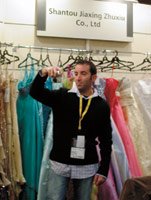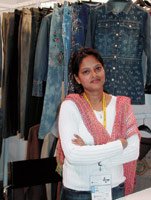End of Quotas Draws Buyers to Hong Kong Fashion Week
HONG KONG—IIke Zakaria landed in Hong Kong after an overnight flight from Los Angeles and, two hours later, began searching for Chinese apparel factories that would help distinguish his family’s clothing stores from other Southern California apparel retailers.
Winding his way through one of the enormous exhibition halls at the Hong Kong Convention and Exhibition Centre, he soon stopped at a booth filled with elaborately designed dresses emitting a certain Cinderella aura. Zakaria was definitely interested in the samples displayed by Brilliant Star Eveningwear Manufacturer Co. Ltd., a company from Shantou, China, that was one of hundreds exhibiting at the Fall/Winter 2005 Hong Kong Fashion Week, held Jan. 18–21. Before long, he was talking about letters of credit and methods of delivery for the fancy dresses, which wholesale from $30 to $60.
Like many buyers who decided to attend the market for the first time, Zakaria acted like an explorer in uncharted territory. Although his family’s 37-store chain, Windsor Fashion Inc., which carries prom dresses and other juniors items, buys much of its apparel through wholesalers and agents, the company is branching out to deal directly with Chinese factories now that apparel and textile quotas have been eliminated among the 148 member countries of the World Trade Organization.
“We want 20 to 25 percent of our inventory to come directly from China,” said Zakaria, the company’s vice president and general merchandising manager. “You can save 40 to 50 percent of your cost by coming direct. It is a big savings.”
The constant talk about how China will become the new apparel factory to the world made the family rethink its direct sourcing program. “It is something we realized we should have been doing,” Zakaria said.
With Windsor Fashion branching out into the Midwest and East Coast of the United States this year, company executives hope to pass cost savings on to customers and be more competitive. In the company’s tightly controlled environment, Zakaria’s 77-year-old father, Maurice, still holds the chief executive title and calls all 37 stores nightly to see how they have done.
Zakaria was just one of hundreds of first-time buyers checking out Hong Kong Fashion Week. Attendance soared to 25,401, a 25 percent increase over last year. A total of 1,087 exhibitors, 11 percent more than last year, set up booths inside the various halls that make up the mammoth convention center, built on reclaimed land that juts out into the beautiful Victoria Bay.
Door open only partially
While everyone was talking about the end of apparel and textile quotas, most Chinese and Hong Kong manufacturers (most of whom actually manufacture in mainland China) were cautious about an open-door policy with the United States. They fretted that the Bush administration would reinstate safeguard measures (or modified quotas) on 12 categories, including wool and cotton pants, dressing gowns, and shirts. Socks are already under a safeguard measure that expires in October.
“There are many, many measures the U.S. can take to impose restrictions this year,” said Daniel Poon, assistant chief economist for the Hong Kong Trade Development Council (HKTDC), which organizes Hong Kong Fashion Week. He noted the United States could enact higher tariffs or antidumping duties to make importing Chinese-made goods less attractive.
That is already happening. Recently, Sen. Charles Schumer (D–New York) said he would introduce legislation co-sponsored by Sen. Lindsey Graham (R–South Carolina) that would impose a 27.5 percent tariff on all imports from China.
Room for optimism
Nevertheless, an HKTDC survey of 445 exhibitors and 716 buyers showed that 74 percent felt that 2005 will be better or slightly better than 2004 as the world economy improves and quotas are reduced. And 71 percent of buyers said they will increase their sourcing activities in Asia, primarily in China and then in South Korea, India and Taiwan.
Quota reduction was not the only reason cited for better business in the coming year.
Fashion played a strong hand in the business outlook for apparel manufacturers in countries such as India. The bohemian look of bright Indian fabrics displayed in gauzy shirts, skirts and scarves boosted orders for Indian companies attending the Hong Kong event.
Most of the 55 companies that participated in the Indian Pavilion, partially subsidized by the Indian government, had a happy story to tell.
“This is the best show we’ve ever had,” said Vikas Agarwal, a nattily dressed young man who said he attends the show every year with his father and uncle. The family’s Aman Exports International, founded decades ago by Agarwal’s grandfather in Jaipur, India, received 200,000 orders for brightly colored T-shirts and tops, compared with 50,000 orders last year. Forever 21 Inc., a Los Angeles chain that sells cheap and chic clothes to juniors, placed an order for 30,000 colored T-shirts finished with beading at the bottom, Agarwal said. The shirts wholesale from $5 to $6 and are made in the family’s factory, which employs 1,000 people who work 11 hours a day for $50 a month. The Woolworths Group in England placed another big order for 50,000 tops, according to Agarwal.
Chinese face competition
The Chinese and Hong Kong companies that made up the bulk of the participants at Hong Kong Fashion Week saw mixed results from the fair. Many Hong Kong companies booked brisk business. But some mainland Chinese companies expressed concern about the increased competition in their country now that all apparel factories can export goods, not only those who bought quota allotments from the Chinese government.
“Our business is just so-so,” said Bright Chen, a salesman from Ningbo Orient Hongye Fashions Co., a 10-year-old company that makes knit tops for men, women and children. “There are too many suppliers.”
Samson Shen looked bored as he sat at his booth, surrounded by the screen-printed T-shirts and sweat shirts he sells from his Chinese factory, which does business under the name Ningbo Kingtex Ltd. “No one has placed any orders,” he said, noting that often buyers prefer to place sample orders to make sure a factory delivers goods on time.
But Michelle Jiaxing of Brillant Star Eveningwear in Shantou said this was the best Hong Kong Fashion Week she had attended in the last three years.
Equally happy was William Fung, owner of Suntex Ltd., a Hong Kong company that manufactures linen and silk blouses in southern China. “It appears that buyers are back,” said Fung, who estimated his orders were up 50 percent over last year.
Genevieve Lam, managing director of Hillier Fashion in Hong Kong, said she expects orders for her women’s business suits to increase 25 percent over last year.
“The only reason for the increase is [no more] quotas,” she said. “Everyone wants to see the possibility of making clothes in China.”
Mixed reports at World Boutique
The mood at World Boutique, the 3-yearold fashion-forward satellite show spun off from Hong Kong Fashion Week, was less than enthusiastic. In the stylish area that showcased designer collections and brand names, participants complained about the lack of traffic and business compared with the other areas of Hong Kong Fashion Week. Still, show organizers said 15,440 buyers visited World Boutique this year, nearly 9 percent more than attended last year.
“We’re not coming back next year,” said Raymond Jibrayel, head of Soul Edge Corp., based in Marseille, France.
The company, which attended World Boutique last year, set up two huge booths this year to display its denim, sold under the Soul Edge label and under a newer label called Para Nada. Jibrayel looked for new distributors in Asia but did not see results. “There are only copycat people with cameras coming by,” he said.
Hyphen Jeans New York, a 2-yearold company based in Hong Kong, spent two years preparing to attend World Boutique. Production Manager Fredson Ng said a few buyers stopped by but not many placed orders. “It’s step by step,” he noted.
One person who did extremely well at World Boutique was Giovanni D’Angelo, president of Itemco Inc., a Montreal-based global sourcing company with offices in Shenzhen, China. D’Angelo, whose simple booth was lined with dozens of men’s jeans, said he opted to participate in World Boutique because he could not get into the Bread & Butter show in Berlin or Interstoff Asia in Hong Kong. Both shows were booked up, he said, but World Boutique, with only 200 exhibitors, still had space available.
To highlight his sourcing and production capabilities and show what his company could do in China, D’Angelo whipped up a fashion-forward sample line called 3 Fishes. But more people were interested in the sample line than in sourcing. “This is a total fluke,” he told one British buyer.
D’Angelo said a chain of 400 stores in Germany, as well as a chain of 30 stores in Poland, was interested in carrying the 3 Fishes line. “Absolutely, without a doubt, this has been great,” he said.
























